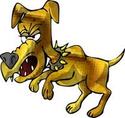Fear and Aggression in Puppies
by Lotte Griffiths – Accredited Behaviour Consultant (Canine) (ABC of SA™)
If your puppy does at any stage develop fearful and/or aggressive behavioural patterns, we strongly recommend you consult with a qualified canine behaviourist.
When dealing with fear-aggression it is crucial to avoid placing your puppy in a position where it may feel ‘cornered’ or feel that its personal space is being invaded. Do also remember that it can be hazardous to attempt to forcibly remove puppies from a ‘places of safety’ – such as crates or any other enclosed area.
Never attempt to treat aggressive behaviour with aggression such as smacking. Apart from being counter-productive, it can also be exceedingly dangerous because:
Your puppy might just retaliate!
You can never be certain what your puppy might associate with the punishment and therefore there is no guarantee that your puppy will realise it is his or her own behaviour which causes the punishment. That means that you puppy may just as easily associate the punishment with, say, a visitor or child and think it’s the visitor’s or child’s “fault” he is being punished which, in turn, will result in your puppy becoming even more aggressive towards visitors and children
Alternatively, your puppy may associate the punishment with the punisher (you) which, apart from seriously damaging your relationship, will make the resultant behaviour dependant on whether or not you are present. The result of this may be that your puppy doesn’t growl or snap at visitors and children when you are present but it does not guarantee that he will not do so in your absence.
Pets and Strangers:
It should always be your puppy (or older dog’s) choice as to whether or not he wants to interact with visitors and strangers. If your puppy does not want to be petted by your visitors or strangers they meet on walks do not allow anyone to force him to interact.
When dealing with fear-aggression it is crucial to avoid placing your puppy in a position where it may feel ‘cornered’ or feel that its personal space is being invaded. Do also remember that it can be hazardous to attempt to forcibly remove puppies from a ‘places of safety’ – such as crates or any other enclosed area.
Never attempt to treat aggressive behaviour with aggression such as smacking. Apart from being counter-productive, it can also be exceedingly dangerous because:
Your puppy might just retaliate!
You can never be certain what your puppy might associate with the punishment and therefore there is no guarantee that your puppy will realise it is his or her own behaviour which causes the punishment. That means that you puppy may just as easily associate the punishment with, say, a visitor or child and think it’s the visitor’s or child’s “fault” he is being punished which, in turn, will result in your puppy becoming even more aggressive towards visitors and children
Alternatively, your puppy may associate the punishment with the punisher (you) which, apart from seriously damaging your relationship, will make the resultant behaviour dependant on whether or not you are present. The result of this may be that your puppy doesn’t growl or snap at visitors and children when you are present but it does not guarantee that he will not do so in your absence.
Pets and Strangers:
It should always be your puppy (or older dog’s) choice as to whether or not he wants to interact with visitors and strangers. If your puppy does not want to be petted by your visitors or strangers they meet on walks do not allow anyone to force him to interact.
This article is copyrighted and remains the property of the author. Individuals are welcome to print or copy same for their own use in furthering their knowledge of dogs. However, no reproductions or alterations/variations are allowed without the express written consent of the author.

